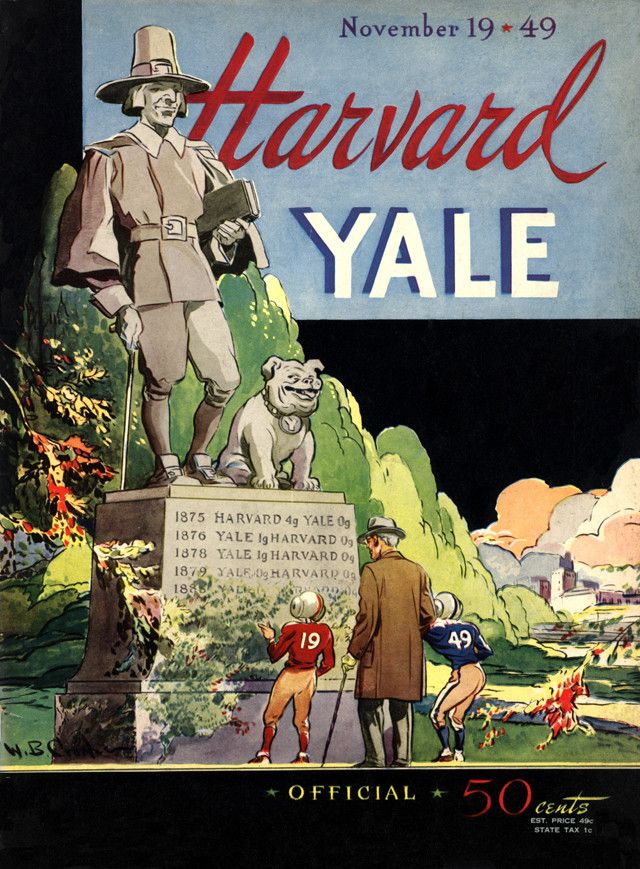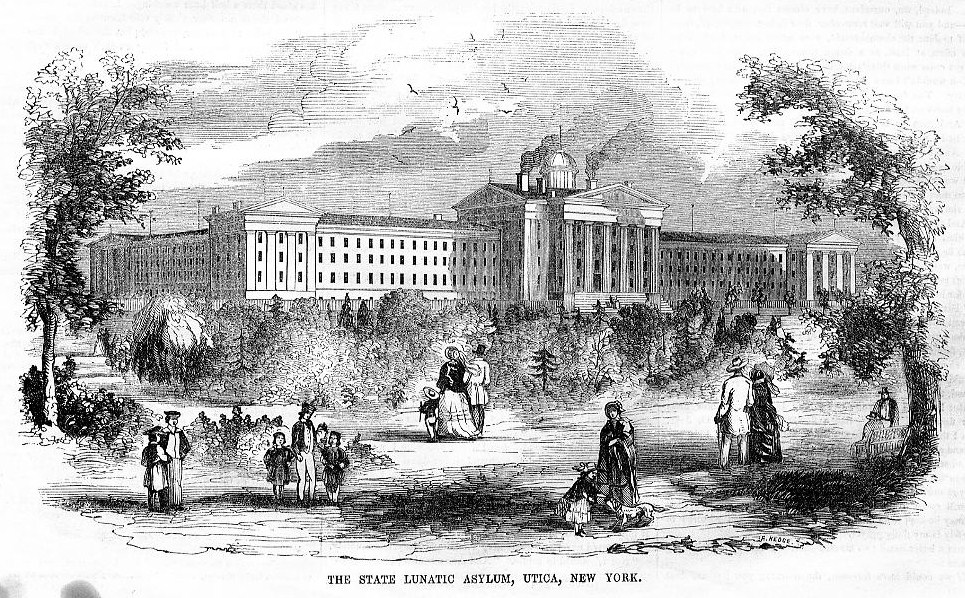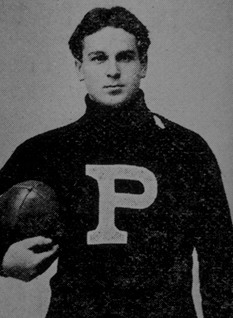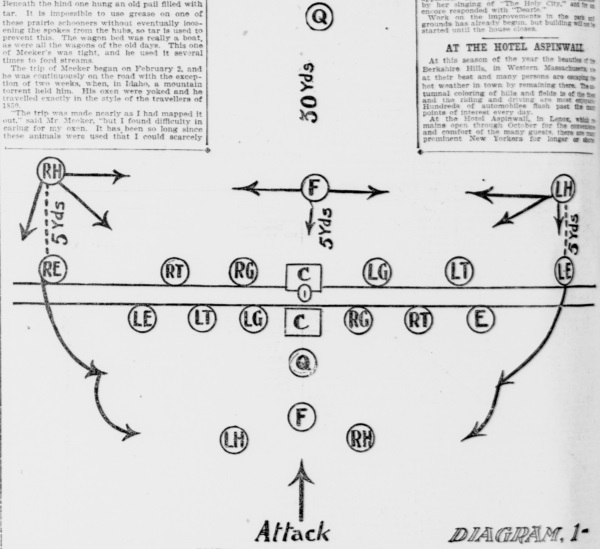19th Century Brutality
Intro
The late 1800s and early 1900s saw Football begin to develop a negative reputation as a result of a large amount of fatalities occuring per year as well as a high amount of injuries and dirty play. In 1905, 18 people died and 149 more were seriously injured as a result of the sport. For comparison, in 2018 there were 16 total fatalities recorded despite the sport being infinitely larger in size.
In one example, an 1894 matchup between Yale and Harvard which is commonly just referred to as the "Hampton Park Bloodbath", seven players were removed from the contest as a result of serious injury and two more were ejected due to getting into a fist fight. One player fell into a coma for several hours. The results of the game were so shocking that the two universities cancelled games against eachother for two seasons.
Another infamous example occured in 1897 between Georgia and Virginia. In it, UGA Fullback Richard Von Albade Gammon suffered a life ending injury. He was on defense and dove into UVA's right tackle and suffered a severe concussion. After he was being taken off by Coach McCarthy until Team Captain William B. Kent, unaware of how badly he was hurt, asked him: "Von, you're not going to give up are you?". He responded by saying "No Bill, I've got too much Georgia grit for that." Making his way back over torwards the sideline, he collapsed and was later pronounced dead. This event stunned UGA's players as much as it did UVA's, and nearly snowballed into getting the entire sport outlawed until Gammon's mother wrote to a representative, who later showed it to governor Atkinson, to convince him not to go through with it. He would veto the bill.

INSANE FROM AN INJURY AT FOOTBALL.
Source
A STUDENT AT FEIRFIELD SEMINARY BECOMES SUDDENLY VIOLENT-SECURED BY A STRATAGEM
Little Falls, N.Y., Nov. 24 (Special).--B. Foote, of Deansville, N.Y., a student at the Fairfield Seminary, seven miles from this village, became violently insane on Sunday night in consequence of an injury received in a football game. Foote was centre rush for the seminary eleven, and was a good player and enthuisastic over the game.
On Saturday the team played at Fort Plain against the strong team of the Clinton LIberal Institute. In the course of the game Foote was hurt on the head, but the injury was apparently trivial. On Sunday night at about 1 o'clock Foote arose and dressed himself in his football suite. Sleeping with him was a young fellow from Syracuse, his room-mate.
Foote seized him and threw him violently to the ground, crying "Now, are you down!" His room-mate shouted "Down!" and at the same time cried for help, realizing that Foote was a raving maniac and was likely to do him harm. Before assistance could be had the insane lad fiercely jumped upon him. Several sutdents rushed into the room, and Foote, seeing them, threw his valise at the leader, shouting "Now catch the ball and go around the end!" The valise struck the student in the head and feiled him. Foote then seized a water pitcher and an oilean, and with these weapons held the students at bay.
Badly frightened, they made for their rooms and locked the doors. One student, who was in the hail, was pursued by the insane youth, and to escape him jumped from a second story window thirty feet to the ground, hurting his knee pan. He managed, however, to hobble to the building occupied by the faculty and aroused them. Ladders were procured and the students who had sought refuge in their rooms were rescued from the windows.
Foote amused himself till daylight in lining up against the doors, and, with his valise for the football, rushing and knocking them off their hinges. He guarded the stairs and would not let anyone near him. He also threw various articles through the windows. No one would venture near the lead to capture him. Finally the football team lined up int he yard below, and Foote, seeing them, went down and took his plae as centre. Then a constable seized him from behind and bound him. He was placed in a room and his parents were sent for. They took him to the Utica Insane Aslyum, where he is now confined. The football team has been disbanded.

Public Sentiment
Continuing from the above summary on growing tension regarding violence in the sport, there was a growing movement of people who wanted the sport outlawed. Teddy Roosevelt, himself a fan of Football, began to threaten outlawing the sport via presidental edict.
In 1905, another incident occured which began to bring things to a boiling point. Bob "Tiny" Maxwell was a speedy 250 pound guard and by far the best player on the small, limited football team of Swarthmore college. One of the teams they played, the much larger University of Pennsylvania, knew this and acted accordingly. The better than usual but still ultimately dependent on Maxwell Smarthmore team played valiantly but ultimately lost to Penn by a final line of 6-11.
More notable for our story is a picture that emerged of Maxwell after the game; knowing that he was their primary threat Penn began to blatantly target and hammer Maxwell all game long, figuring if they stopped him they stopped Swarthmore's attack. The result was Maxwell appearing a bloodied, staggered mess by the end of the game. An opportunistic photographer snapped his picture which lead to outrage especially from those who wanted the sport banned. Teddy Roosevelt himself was apart of this outrage, gasping in horror at sight of the picture and then afterwards proclaiming that "Brutality and foul play should receive the same summary punishment given a man who cheats at cards."
Unfortunately I haven't come across a surviving version of this picture, though based on the accounts of it I doubt most would want to see it anyway.
With tension now the highest it'd ever been, the eventual NCAA Rules Committee met and began discussing ways to reduce brutality within the sport. The most famous rule change and also of much support from legendary coach John Heisman was the legalization of the forward pass, much to the shagrin of Walter Camp. Partially resulting from Camp's influence as an early figure in the history of the sport, the committee, while it did legalize the forward pass, made it so restricted and impractical that many teams flat out ignored it's existence while others used it once every blue moon.
For instance, if a pass went out of bounds or touched the ground it would be turned over to the opposing team. The first team to really utilize the forward pass was the 1918 Notre Dame football team, which will definitely have a page in the Early CFB section in the future. Alongside this eventually revolutionary rule change, three others were altered or put into place.
Firstly the committee made it so that at least 6 people had to be on the line of scrimmage, in attempt to prevent mass plays. Second the committee created the "neutral zone", which was about the width of the football between the two opposing lines. This greatly restricted the potential for punching, kicking, etc. within the pileups which was a very common thing in the early days of football and not particularly looked down on whatsoever. Thirdly, in an effort to try to get teams to get more creative and innovate on the offensive side of the ball, as well make the sport a bit more watchable and spectator friendly, they increased the yards required to get a new set of downs from 5 up to 10.
This had an unintended effect of making kicking and punting far more common; there were only three downs at this point in time and many teams didn't want to risk setting up the opposition deep in their territory. Six years later in 1912, the fourth down was added which reduced the kicking frequency considerably. The Canadian Football League to this day sticks to the old three down for ten rule funnily enough.
Contrary to the popular narrative, the 1906 rule changes were not responsible for saving football. In fact, the deaths relating to football actually increased in 1906 though they did begin to fall afterwards. They are however a good beginning point if one were to try to determine where the game first took it's modern shape. The main effect of the 1906 rule change outside of the rules themselves is that it showed the football big wigs were willing to listen to the general public and make changes with respect to player safety.
Below is a piece from former player and man of the era George W. Brooke, who was contacted after the rule change to write an article for the New York Daily Tribune on September 23rd 1906.

How to Play Football Under the New Rules
Under the new rules the game will be more open and spectacular, and it is to teach the scientific intricacies of what otherwise might seem nothing but a wild scramble that these articles are intended. The new plays that will be used by the tacticians this fall will be of tremendous interest to the great football public, and every one should have a thorough understanding of them to really appreciate the great American college game.
Football has just passed through a drastic period of reform and we are entering on a new era of the game. The old style of play has been almost totally changed by the new rules recently formulated. New attack, new defence, and almost new rudiments have to be learned and taught in 1906. Beyond a doubt the game will be more open. There will certainly be a great deal more kicking, flueks, passing, tricks, open field running and general hurry scurry. The old certainty which was so satisfactory to the coach as we watched his cohorts carry out the well planned tactics has given way to uncertainty. The massed play posible under the old rules required a remarkable concentration of defence. There were two lines of defence--first and secondary. The secondary line would dart in to help out the first or rush line with a fierce certainty that was a beautiful sight to the initiated. Under the new rules there will be little or no concentration of the defence. The rules making ten yards necessary to be gained in three downs and doing away with massed plays make concentration of defence unnecessary. Then, again, there is the allowance of a forward pass under certain conditions; and more radical yet, the rule that allows any one to get a kicked ball after it touches the ground.
Just here I will put in a few words to beginners. In my long experience in coaching I have noted that even with veterans of the year before a coach has to repeat details continually in order to keep them thoroughly impressed on the minds of the players. The most conscientious player has to learn over and learn again a lot of the helpful little details every season. The first thing to do is starting football season is to get enough boys to form a squad. You will need more this year than ever before on account of the new rules about delaying the game, injuries, etc. The first things to practise, even before you get your signals, are quick starting, taking on the ball, handling the ball--that is, catching and passing--picking a ball up on the run and kicking. Quick starting is especially important for the four men who play back of the line-- the quarterback, halfbacks and fullback. It is also important for the linemen to know how to get out of the line quickly, so that they can back up on defence and get into the interference, possibly, on offense. Falling on the ball at full run will be extremely necessary this year because everyone is on-side after a kicked ball has touched the ground--that is, everyone has equal right to get the ball. Picking the ball up on the run may often prove useful when no opponent is around.
Right here I will might as well take the reader into confidence and tell him that neither the writer nor any one else knows at this stage of the season just what moves will be made on the gridiron this fall. We are in the experimental period.
It is my object to scheme and plan a simple and strong system of play under the new rules and give my reasons for every move. In this way, which I think will be interesting if followed closely, the reader can watch the unfolding of a system of playing football. The beginner will be helped and the spectator will be surprised to find how his interest increases when he understands some of the underlying reasons of football tactics. As the season advances the ideas of other coaches will be woven into our discussions.
You will note the general formations there shown are not so radically changed from what they were under the old rules. What changes there are, however, will come out very plainly when our pictured players begin to move.
There are number of the principles of old football which will be preserved in the new. When there is a change the line of departure will be clearly shown, with the reasons therefor. For the first time in our football a forward pass is allowed. It must be made, however, by one of the backs, and must be caught either by a back or an end. It is doubtful, however, if this pass will be used much, because if it touches the ground without hitting anyone first it goes to the other side of that spot (turnover to other team). Still, however, it forming any defence, this forward pass much be taken into consideration. It may be made at any time during the scrimmage (possession), but only once during each scrimmage.
Instead of a team being obliged to gain five yards in three downs, they must now make ten yards in the same number of attempts. The result of this will be that there will be a great deal more punting than ever before. This punting will be further encouraged by a new rule which provides that whenever a kicked ball hits the ground everyone will be on-side and anyone can get the ball.
In general, we might say that the new rules have weakened and changed the attack in the following ways. First, by requiring ten yards to be gained in three downs. Second, by a rule requiring the linesmen to stand in such a position that they cannot get out of the line very quickly in order to get in the interference. Third, by doing away with massed plays. Fourth, by doing away with hurdling. Fifth, by creating stricter rules about the use of hands in making openings in the line.
In general, we might say that the attack had been strengthened by the allowance of the forward pass and by putting everyone one on-side when a kicked ball hits the ground. Also by the rule barring tackling below the knees. These are the very important changes and their workings will be amply explained as we progress.

Diagram number 1 (shown above) is our checker board, so let us get to ework. First look at the positions in which I have placed the players on the defence, that is, the side which has not got the ball. We have to see the defence in order to plan the attack. When a general attacks a fort he studies how it is defended.
The first thing that will strike you is that the two rush lines are playing further apart and that the secondary line of defence is placed further back from the line of scrimmage, and the two halfbacks in this secondary are placed further our wards their respective ends. Why is this? In the first place the two rush lines are forced to play a foot further apart. See rule 5, page 104, of the new rules.
"The line of scrimmage for each side is an imaginary line parallel to the goal line and passing through that point of the ball nearest the side's own goal line." It follows that there are two lines of scrimmage, one for each team, and just the length of the ball part.
Probably the reason that this rule was made was so that the one umpire could look down the space between the lines and detect more clearly any infringement of the rules. Holding or slugging would be easier to detect.
And, furthermore, it is very probable that the linesmen on defence would want to play a foot or two away from their opponents anyhow. Why? The answer to this brings out one of the most important principles that will be a part of any system under the new rules. I cannot make it too plain.
That word "charge" has hung over the battle scarred gridirons of the past like a call to arms. A linesman who could not "charge" was useless. A "charge" was the sudden powerful spring forward of the linesmen to meet their opponents, and whichever linesman was the suddenest usually bent his opponent back and stopped the heavy massed attack. If the defending linesman was himself bent back then the tandem mass aimed at him would crush on over for a couple of yards or more.
But the mass play has been ruled out and because of the new ten-yard rule the defending team is not so afraid of short gians. For these reasons the coaches will not put much stress on charging, but will rather teach the linesman to be nimble and active in backing up all along the line and outside the ends. Take, for instance, the right guard. All he used to do was to protect his own position and help out the centre rush and right tackle if he was not too busy with his own man. This fall you will probably see the guard tackling all over the field. His duties will be doubled, for he will have to watch the attacking backfield like a hawk to see what it is going to do, and he will have to look out for plays aimed straight at him and also out at the tackle or end.
Therefore, in order to get out of his position quickly, he will want to stand a little back from the line of scrimmage. This backing up theory will be varied and enlarged as we progress.
Next let us go to the diagram once again and take a look at the second line of defence. Note that it is playing further back and more scattered than it was last year. The half backs are practically secondary ends, whereas they used to play just back or inside of their tackles. Why is this?
First, because the second line of defence is afraid of forward passes and the short kicks where everyone is on-side when the ball hits the ground.
Second, because the second line of defence is not so afraid of short gains, and therefore, does not have to spring to the support for the first line of defence so sharply as it used to do. Third, because the second line of defence is afraid of long end runs.
Undoubtedly this year in planning the attack a coach will lay great stress on the forward pass and the kick, because they are the only two new rules that favor his attack. Without them the balance of power would be completely in favor of the defence. The new rule that puts everyone on-side the instant a kicked ball hits the ground is an extremely important rule.
Now let us instance a possible play. Suppose the second line of defence was playing close up to the first line, like it did last year, and not like it is playing in the diagram. A sharp, clever quarterback on attack would instantly signal for a short kick. He would make it himself, just over the heads of the secondary line of defence, and his linesman would dash through and get it the instant it hit the ground. The quarterback on defence has to play away and back, and he could not get to it in time. By moving your second line of defence back a little you can cover your territory against these dangerous little punts.
The forward pass can be made one in each scrimmage by the attacking side only. It cannot be made over the line of scrimmage within five yards of either side of the centre. if it hits the ground before it hits a player of either side it can go to the defending side at that spot. It can only be made by a back field player and can only be called by a back field player or an end rusher. it can be made anywhere in the field of play except, as has been said, over the line within five yards of centre.
There are a number of good plays that can be developed from the forward pass, so in forming your defence it has to be taken into consideration.
The quarterback, who is generally a swift open field runner and a sure catcher and tackler, plays about thirty yards back on defence.
Just how far back he plays will be important this year. Why? Because he must be able to get to every kicked ball in the territory not covered by the second line of defence before the opposing end rushers, whose side is kicking, can get there. Neither must he let the kick sail on over his head. Remember that the cards are on-side the very instant the ball hits the ground, and their punter will probably send his kicks low for that reason.
In placing the quarterback on defence a coach must take into consideration that the opposing ends can usually get several yards' start down the field before the ball leaves the kicker's foot.
For this reason it will be more important than ever before to block those end rushers. Thus I have outlined in general the defence which we will have to plan to overcome, and incidentally anyone with half an eye can see the great amount of detail that comes up in learning scientific football.
Next week I'll start in on a general outline of attack and take up signals. In the meantime practise hard at quick starting, kicking, handling the ball and falling on it.
References
New York Tribune, November 25th 1894New York Tribune, September 23 1906